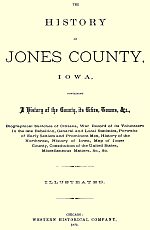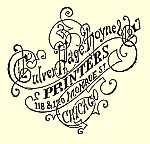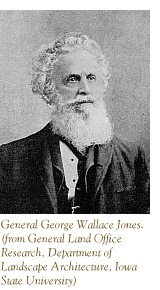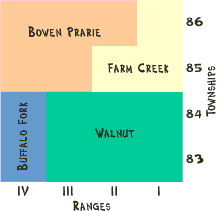



|
|
COUNTY ORGANIZATION
 The The county of Jones was named and its boundaries designated at the session of the Wisconsin Legislature held at Burlington in the winter of 1837-38. At that time, the country now included in the State of Iowa belonged to, or was a part of, the Territory of Wisconsin. There were but two counties west of the Mississippi River in 1836-Des Moines and Dubuque. During the meeting of the first Territorial Legislature, in 1836-37, Des Moines County was subdivided, and, at the meeting of 1837-38, Dubuque County was lessened by the creation of Clayton, Fayette, Delaware, Buchanan, Jackson, Jones, Linn, Clinton and Cedar Counties. Gen. George W. Jones, of Dubuque, at that time represented the Territory of Wisconsin in Congress. In his honor was the county, whose history we write, named. county of Jones was named and its boundaries designated at the session of the Wisconsin Legislature held at Burlington in the winter of 1837-38. At that time, the country now included in the State of Iowa belonged to, or was a part of, the Territory of Wisconsin. There were but two counties west of the Mississippi River in 1836-Des Moines and Dubuque. During the meeting of the first Territorial Legislature, in 1836-37, Des Moines County was subdivided, and, at the meeting of 1837-38, Dubuque County was lessened by the creation of Clayton, Fayette, Delaware, Buchanan, Jackson, Jones, Linn, Clinton and Cedar Counties. Gen. George W. Jones, of Dubuque, at that time represented the Territory of Wisconsin in Congress. In his honor was the county, whose history we write, named.
 Only a part of these counties were organized at that time. Jackson County was equipped with an Organizing Sheriff in the person of William A. Warren, of Bellevue. He was also, in a limited sense, made the Sheriff of Jones and Linn Counties; and, for matters of court jurisdiction, Bellevue was, during 1838 and a part of 1839, the capital of Jones and Linn Counties. As election precinct was designated in each of these, and the report of votes sent to Bellevue. Only a part of these counties were organized at that time. Jackson County was equipped with an Organizing Sheriff in the person of William A. Warren, of Bellevue. He was also, in a limited sense, made the Sheriff of Jones and Linn Counties; and, for matters of court jurisdiction, Bellevue was, during 1838 and a part of 1839, the capital of Jones and Linn Counties. As election precinct was designated in each of these, and the report of votes sent to Bellevue.
 The first Territorial Legislature, after the separation of Iowa from Wisconsin, met in Burlington November 12, 1838. During the session, the county of Jones was organized. The first Territorial Legislature, after the separation of Iowa from Wisconsin, met in Burlington November 12, 1838. During the session, the county of Jones was organized.
 The act passed by the Legislature to organize the county of Jones was as follows: The act passed by the Legislature to organize the county of Jones was as follows:
|
SECTION 1. Be it enacted by the Council and House of Representatives of the Territory of Iowa, That the county of Jones be, and the same is hereby, organized from and after the 1st day of June next, and the inhabitants of said county be entitled to all the rights and privileges
to which, by law, the inhabitants of other organized counties of this Territory are entitled; and the said county shall be a part of the Third Judicial District, and the District Court shall be held at the seat of justice in said county, or such other place as may be provided until the seat of justice is established. Be it enacted by the Council and House of Representatives of the Territory of Iowa, That the county of Jones be, and the same is hereby, organized from and after the 1st day of June next, and the inhabitants of said county be entitled to all the rights and privileges
to which, by law, the inhabitants of other organized counties of this Territory are entitled; and the said county shall be a part of the Third Judicial District, and the District Court shall be held at the seat of justice in said county, or such other place as may be provided until the seat of justice is established.
SEC. 2 That Simeon Gardner, of Clinton County;
Israel Mitchell, of Linn County, and William H. Whitesides, of Dubuque County, be, and they are hereby, appointed Commissioners to locate the seat of justice in said county, and shall meet at the house of Thomas Denson on the second Monday of March next, in said county, and shall proceed forthwith to examine and locate a suitable place for the seat of justice of said county, having particular reference to the convenience of the county and healthfulness of the location. That Simeon Gardner, of Clinton County;
Israel Mitchell, of Linn County, and William H. Whitesides, of Dubuque County, be, and they are hereby, appointed Commissioners to locate the seat of justice in said county, and shall meet at the house of Thomas Denson on the second Monday of March next, in said county, and shall proceed forthwith to examine and locate a suitable place for the seat of justice of said county, having particular reference to the convenience of the county and healthfulness of the location.
SEC. 3. The Commissioners, or a majority of them, shall, within ten days after their meeting at the aforesaid place, make out and certify to the Governor of this Territory, under their hands and seals, a certificate containing a particular description of the location selected for the aforesaid county seat; and, on receipt of such certificate, the Governor shall issue his proclamation affirming and declaring the said location to be the seat of justice of the said county of Jones. The Commissioners, or a majority of them, shall, within ten days after their meeting at the aforesaid place, make out and certify to the Governor of this Territory, under their hands and seals, a certificate containing a particular description of the location selected for the aforesaid county seat; and, on receipt of such certificate, the Governor shall issue his proclamation affirming and declaring the said location to be the seat of justice of the said county of Jones.
* * * * * * * * * * * * * * * * * * * * * * *
SEC. 6. The Commissioners aforesaid shall receive, upon making out their certificate of the location of the seat of justice of said county, each, $3 per day, and also $3 for every twenty miles going to and returning from their respective homes. The Commissioners aforesaid shall receive, upon making out their certificate of the location of the seat of justice of said county, each, $3 per day, and also $3 for every twenty miles going to and returning from their respective homes.
SEC. 7. Upon the presentation of the certificate aforesaid to the Treasurer of Jones County, the Treasurer is hereby authorized and required to pay the respective sums allowed by this act out of any moneys in the Treasury not otherwise appropriated. Upon the presentation of the certificate aforesaid to the Treasurer of Jones County, the Treasurer is hereby authorized and required to pay the respective sums allowed by this act out of any moneys in the Treasury not otherwise appropriated.
APPROVED January 24, 1839. |
 It seems that these men failed to carry out the provisions of this act, and we find the county seat not to have been located until the following year, or 1840. In the Legislature of 1839-40, three other Commissioners were appointed as follows: Thomas M. Isett, of Muscatine County; John G. McDonald, of Jackson County, and Franklin Moffat, of Delaware County. The probability is that only two of these men served the appointment. We find by the County Commissioners' books that at the July meeting, 1840, Isett and McDonald received $51 and $36, respectively, for their services in locating the county seat. Col. Thomas Cox, of Bellevue, was the surveyor. It seems that these men failed to carry out the provisions of this act, and we find the county seat not to have been located until the following year, or 1840. In the Legislature of 1839-40, three other Commissioners were appointed as follows: Thomas M. Isett, of Muscatine County; John G. McDonald, of Jackson County, and Franklin Moffat, of Delaware County. The probability is that only two of these men served the appointment. We find by the County Commissioners' books that at the July meeting, 1840, Isett and McDonald received $51 and $36, respectively, for their services in locating the county seat. Col. Thomas Cox, of Bellevue, was the surveyor.
 The first election of county officers took place in the fall of 1839. The first election of county officers took place in the fall of 1839.
 Of the County Commissioners elected on this occasion, only two appeared at the recorded meetings of the Board—Thomas Denson and Charles P. Hutton. We have been informed that the third Commissioner was H. G. Seeley. Of the County Commissioners elected on this occasion, only two appeared at the recorded meetings of the Board—Thomas Denson and Charles P. Hutton. We have been informed that the third Commissioner was H. G. Seeley.
 William Hutton was the first Clerk of the Commissioners' Court. Hugh Bowen was the first Sheriff of Jones County. Clark Joslin was the first Recorder. William Hutton was the first Clerk of the Commissioners' Court. Hugh Bowen was the first Sheriff of Jones County. Clark Joslin was the first Recorder.
 There were three polling places at the election of 1839, and were said to have been three precincts-Bowen Prairie, Walnut Fork and Farm Creek. The Judges of the election of 1839 were Orvill Cronkhite, Eli Brown, I. H. Simpson, William Clark, James Hutton and J. C. Raffety. The Clerks were Thomas S. Denson, George H. Brown and D. G. Morgan. There were three polling places at the election of 1839, and were said to have been three precincts-Bowen Prairie, Walnut Fork and Farm Creek. The Judges of the election of 1839 were Orvill Cronkhite, Eli Brown, I. H. Simpson, William Clark, James Hutton and J. C. Raffety. The Clerks were Thomas S. Denson, George H. Brown and D. G. Morgan.
 It will be borne in mind that an election had been held in September, 1838, or one year previous, for the purpose of electing Representatives to the Iowa Legislature. This was in the cabin of Barrett Whittemore. Only eleven votes were cast, and a Representative, R. G. Roberts, was elected from Cedar, Jones, Johnson and Linn. It will be borne in mind that an election had been held in September, 1838, or one year previous, for the purpose of electing Representatives to the Iowa Legislature. This was in the cabin of Barrett Whittemore. Only eleven votes were cast, and a Representative, R. G. Roberts, was elected from Cedar, Jones, Johnson and Linn.
 The first recorded meeting of the Commissioners' Court was held February 3, 1840. Their first act was to appoint Hugh Bowen, Assessor in the place of Daniel Chaplin, who refused to serve. The first recorded meeting of the Commissioners' Court was held February 3, 1840. Their first act was to appoint Hugh Bowen, Assessor in the place of Daniel Chaplin, who refused to serve.
 George Mefford presented a petition for a certain county road. George Mefford presented a petition for a certain county road.
 It was ordered that the regular meeting of the Board should be held thereafter at the house of Donald Sutherland and until further ordered. It was ordered that the regular meeting of the Board should be held thereafter at the house of Donald Sutherland and until further ordered.
 The Commissioners mentioned above as locating the county seat made their report in favor of the northeast quarter of Section 36, Township 85, Range 3 west, where they laid out a town and named it Edinburg. The Commissioners mentioned above as locating the county seat made their report in favor of the northeast quarter of Section 36, Township 85, Range 3 west, where they laid out a town and named it Edinburg.
 An act of Congress provided that, as each new county was organized, the United States Government would grant to the County Commissioners a quarter-section on which the county seat should be located. Accordingly, we find from the book of original entries, that on June 20, 1840, Thomas S. Denson and Charles P. Hutton, as Commissioners of Jones County, claimed the quarter-section above mentioned, being the northeast quarter of Section 36 in what is now Wayne Township. This was within half a mile of the geographical center of Jones County, and its central location was the argument which secured for it the honor of being the first seat of justice. An act of Congress provided that, as each new county was organized, the United States Government would grant to the County Commissioners a quarter-section on which the county seat should be located. Accordingly, we find from the book of original entries, that on June 20, 1840, Thomas S. Denson and Charles P. Hutton, as Commissioners of Jones County, claimed the quarter-section above mentioned, being the northeast quarter of Section 36 in what is now Wayne Township. This was within half a mile of the geographical center of Jones County, and its central location was the argument which secured for it the honor of being the first seat of justice.
 The day after Edinburg was laid out, Col. Thomas Cox, at the solicitation of J. D. Walworth, came to the present location of Anamosa and laid out a town which was called Dartmouth. This was never recorded, and of course came to naught. The day after Edinburg was laid out, Col. Thomas Cox, at the solicitation of J. D. Walworth, came to the present location of Anamosa and laid out a town which was called Dartmouth. This was never recorded, and of course came to naught.
 The first tax levy was made July 6, 1840, being 5 mills on each dollar of taxable property in the county of Jones, and a poll tax of 50 cents upon each voter. The first tax levy was made July 6, 1840, being 5 mills on each dollar of taxable property in the county of Jones, and a poll tax of 50 cents upon each voter.
 We find that Nov. 5, 1840, Clement Russell paid into the county treasury $25, for the privilege of keeping a grocery. We find that Nov. 5, 1840, Clement Russell paid into the county treasury $25, for the privilege of keeping a grocery.
 To those who have not been upon the border, it may be a question why grocerymen in a new country should be so heavily taxed. The initiated will understand that a frontier grocery was simply a saloon of the lowest character, where whiskey was the only article on sale, and which could be obtained at a reasonable price, in any quantity from a glassful to a barrel. To those who have not been upon the border, it may be a question why grocerymen in a new country should be so heavily taxed. The initiated will understand that a frontier grocery was simply a saloon of the lowest character, where whiskey was the only article on sale, and which could be obtained at a reasonable price, in any quantity from a glassful to a barrel.
 The census of 1838 revealed a population of 241. In 1840, this number had increased to 475. The census of 1838 revealed a population of 241. In 1840, this number had increased to 475.
|
|

|
ELECTION PRECINCTS
 At a meeting of the County Commissioners, July 6, 1840, Jones County was divided into four precincts for electorial purposes as follows: At a meeting of the County Commissioners, July 6, 1840, Jones County was divided into four precincts for electorial purposes as follows:
Walnut Precinct, comprising Townships 83 and 84, in Ranges 1, 2 and 3 west of the Fifth Principal Meridian.
Buffalo Fork Precinct, comprising Townships 83 and 84, Range 4 west.
Bowen Prairie Precinct, comprising Congressional Township 86, Range 2, 3 and 4, and Township 85, Ranges 3 and 4.
Farm Creek Precinct, comprising Township 85 and 86, Range 1, and Township 85, Range 2.
 The civil partition of Jones County in 1840, might, therefore, be represented as follows: The civil partition of Jones County in 1840, might, therefore, be represented as follows:
 The Judges of Elections appointed at the time of organizing the precincts were:
The Judges of Elections appointed at the time of organizing the precincts were:
For Bowen Prairie—William Dalton, William Clark and Charles Johnson. Election to be held at the house of Joseph E. Green.For Walnut—Moses Garrison, Isaac H. Simpson and O. Cronkhite. Election to be held at the house of Norman Seeley.
For Buffalo Fork—John G. Joslin, Clement Russel(sic) and G. H. Ford. Election to be held at the house of Clement Russell.
For Farm Creek—Joseph Peet, Hezekiah Winchell and John E. Lovejoy. Election to be held at the house of Abraham Hostetter.
 Bowen Prairie Precinct was made Road District No. 1, with Franklin Dalbey, Supervisor; Buffalo, No. 2, with Clark Joslin, Supervisor; Walnut, No. 3, with John Merritt, Supervisor, and Farm Creek, No. 4, with George Mefford as Supervisor. Bowen Prairie Precinct was made Road District No. 1, with Franklin Dalbey, Supervisor; Buffalo, No. 2, with Clark Joslin, Supervisor; Walnut, No. 3, with John Merritt, Supervisor, and Farm Creek, No. 4, with George Mefford as Supervisor. |





 The
The








 The
The


